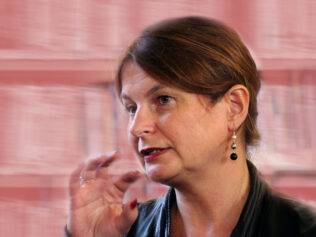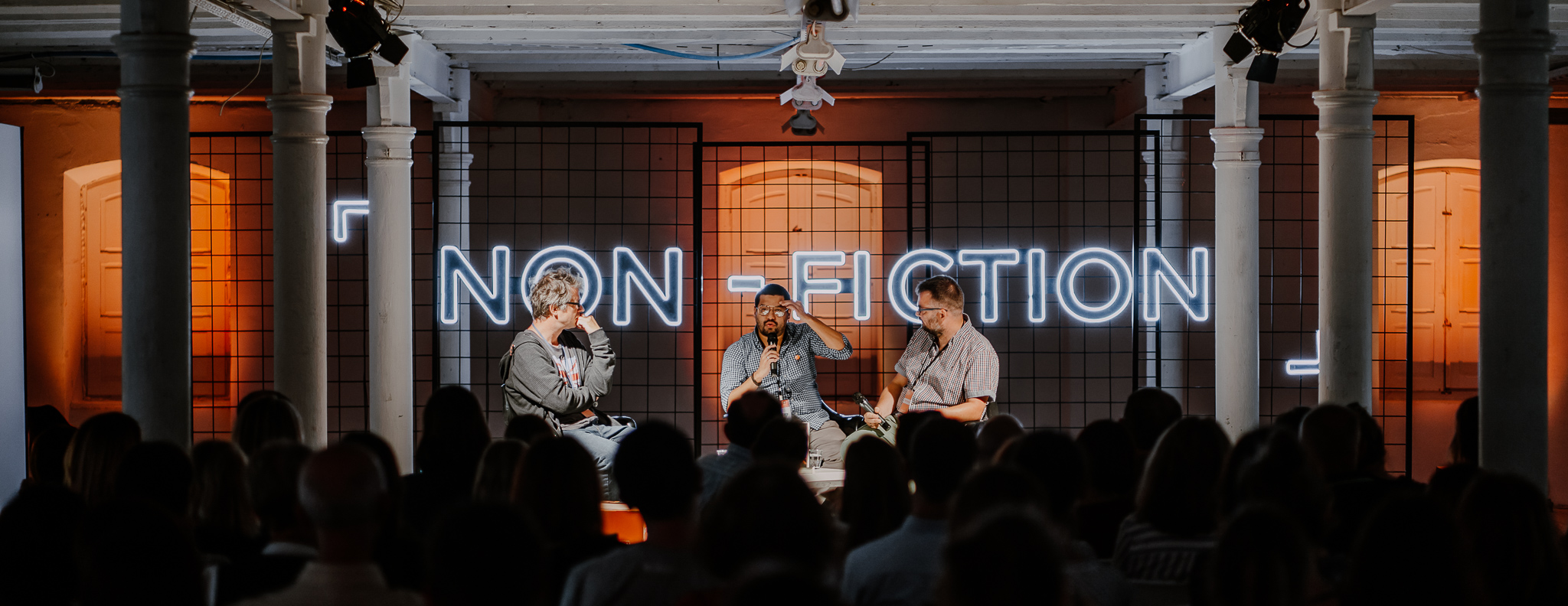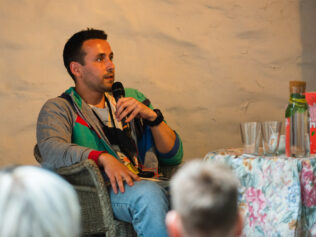
A Swedish journalist undertook an investigation that shook the Swedish Academy, caused a scandal and provoked one of the biggest debates in recent years in Sweden. Mathilda Gustavsson, author of The Club: A Chronicle of Power and Abuse at the Heart of the Nobel Scandal, talks to us about the investigation, Jean-Claude Arnault’s rape victims, and her own position. She spoke to Paulina Małochleb.
Paulina Małochleb: When the scandal surrounding Harvey Weinstein’s actions erupted, the editorial office of Dagens Nyheter started looking for a similar affair in Sweden. Why did you choose to look into the gossip around Jean-Claude Arnault?
Mathilda Gustavsson: Because the gossip was vague, but we kept hearing it from different sources. 10 years ago, when I still lived in a small town, a friend from Stockholm had told me about Forum club – I was very envious that he was going to a place where he could meet so many famous faces from world of literature; that he could visit some amazing exhibitions. I wanted to go to that club too, but he immediately warned me that the artistic director, Jean-Claude Arnault, liked to touch up his assistants. So when the #MeToo movement started to grow in strength, I decided to check what lay behind those rumours. I think many journalists all over the world, both male and female, wondered whether something similar might be happening in their environment, if men like Harvey Weinstein were active there too. At first, I thought something like that could never happen in Sweden, because we’re too small, open, modern, democratic a country. But then I remembered those rumours.
What did you discover during your investigation?
First and foremost, that the gossip was just a faint echo of what really happened, because Arnault didn’t just molest his victims, he also raped many of them. He ran a literary-music club, it attracted many artists, male writers and young, aspiring female writers, often students with dreams of a career. Arnault was the husband of an eminent poet and member of the Swedish Academy, Katarina Frostenson, and the two of them built a very powerful brand for the club. As soon as I started collecting material, when I first put out word that I was interested in the topic, I immediately started getting reports about his victims – he picked so-called ‘fragile women’, young women, who lacked self-confidence, were in weaker positions, but had ambitions. He intimidated them or promised them a way into the literary world. It didn’t take very long to collect the testimony of 18 women, whose stories became the basis for my article.
But later, when it came to the book, did you carry out many more interviews?
Yes, overall I collected hundreds of reports. I found the entire investigation – for both the article and the book – very hard. Above all, because I held the majority of these conversations over the phone, and because they were awful, horrifying accounts of women who had been raped or molested many years ago and were talking about it for the first time. We had numerous, extensive conversations, I asked the most difficult questions – about how the rape happened, their relationship with Arnault, or why they hadn’t gone to the police. The majority of them had to confront the violence again, their own shame, the silence, the knowledge that most people knew about his behaviour and accepted it, because no-one ever exposed what was happening.
What kind of behaviour was it?
At social events Arnault would put his hand between their legs, he’d try to stroke them, feel them up, in the end he committed rape, he’d choke them during sex. He propositioned sex repeatedly and persistently, telephoned relentlessly, invited them to his place or invited himself to theirs. It often happened in front of other people, including his wife – I heard many accounts like that.
Why did witnesses of his behaviour – and this went on for many years – never stop him?
I believe it’s because of a sense of complicit guilt – the first time it happens, we often don’t know how to react, because no-one’s ever taught us. The second time we already feel we’re entangled in the situation, that we’ve allowed it to happen. As well as that, in the case of Jean-Claude Arnault, there was another kind of fear: fear for their own career and position if they spoke out against him. We also have to remember that before the eruption of the #MeToo movement, cases of harassment were often trivialized, victims were regularly accused of having provoked the perpetrator. They were seen as circumstantial cases, because they were only based on the victim’s statements, and therefore difficult to prove. But I don’t want to be too judgemental, because the media was also involved. Even when rape accusations were written about in the press, it was generally in the gossip columns, not on the front page, not in the society section. That was also a barrier for me during my investigation. At first, many women were afraid that I wouldn’t take them seriously, that it would be impossible to prove anything against Arnault. At the same time, the number of accounts I collected testified to the scale of the matter.
In your book, you write that there was another cause of the shame and silence: often, Arnault’s victims didn’t react to his attacks by resisting or crying out; often they accepted it, taking it to be a more difficult kind of sex, or because they’d got into that relationship themselves. They were ashamed they’d let it reach the point of violence, that they hadn’t ‘behaved like real feminists’.
I began work on this story to expose the perpetrator, but today I think it reveals another important issue: it shows that different types of sexual violence exist. Because society teaches us that rape only happens when it’s accompanied by the use of force, when the victim objects to it loudly and clearly, and the perpetrator abuses her with violence, despite that opposition. Yet in the case of Arnault, that kind of occurrence was rare – many women got involved in relationships with him, many invited him to their homes, one – during intercourse, which he initiated when she was asleep – woke up and demanded he stop. Some of them treated that violence as a kind of necessary payment for entering the literary world, as he’d promised them. That certainly does not mean the violence stops being rape. It doesn’t. And the victims are in no way guilty.
The economic advantage is also significant here.
Yes, because Arnault moved in the uppermost circles of Swedish intellectual life. He was friends with members of the Swedish Academy, he enjoyed the trust of university professors (the supervisors of some of his victims), editors and publishers. He managed an apartment in Paris that belonged to the Academy and he was paid for that task. What’s more, he was allowed to spend time there, and although the rules stated that only he and members of the Academy could spend time in the apartment, he sometimes took his partners there, partly to impress them and partly to abuse them far from the eyes of potential witnesses. Arnault ruined many lives, he destroyed many women’s dreams, because after the rape, some of them gave up writing and completely changed their profession. Many of them worked at Forum as young women, and when they left because they couldn’t stand his company any longer, he fired them without references or pay.
How did the Swedish Academy react when you wrote your article?
They tried to deal with the matter in the old way, sweeping it under the carpet as a malicious attack on a major figure of the Swedish literary establishment. It was thought that a highly-cultured man, a brilliant artist and sophisticated intellectual was incapable of behaving in such a primitive way. Meanwhile in my first discussion with Sara Danius, Permanent Secretary of the Swedish Academy, she told me that of course she’d heard the gossip over the years, but she’d never thought the matter was so serious, which really only served to prove the scale of the conspiracy of silence, and showed which circles were embroiled in it. The Academy explained that they didn’t want to deal with the issue, to avoid conflict and a strange, tense atmosphere. That kind of explanation reflects the old rhetoric, from before #MeToo, when cases of harassment and rape were seen as ‘strange’, ‘causing tension’, and as a rule, inconclusive. That was the initial reaction: wait it out, don’t take it seriously. But then something snapped within the Academy, in the end they hired a company to clarify the matter in a separate, independent investigation.
How did you feel when your text provoked so many reactions, brought you fame, and you began giving interviews, but journalists often described you as ‘young’ or ‘shy’?
They used those words about me in surprise and shock, because my investigation caused such a scandal, it undermined the Academy’s authority, and no-one expected that a young, shy person would have been able to carry it out. And yet, I actually think it’s those features that underlie my success: I didn’t pose a threat to any of my subjects, who felt quite safe with me (there can be no talk of feeling totally safe in the case of victims of sexual violence), they trusted me more and opened up in our conversations. What’s more, I also arranged to interview many friends and close acquaintances of Jean-Claude Arnault, to better understand that environment, to confirm the circumstances my subjects described in their stories. Those men, but also some women, would never have agreed to an interview with a man, they’d have felt threatened by him and would have been more careful about what they said. But they felt that someone like me had no power and wouldn’t be able to harm them, however hard I might try. In the company of a ‘young and shy’ person, they felt in control of the situation, didn’t pay complete attention to what they were saying, and that worked in my favour.
Perhaps those characteristics are necessary for anyone writing about sexual violence?
Yes. You have to remember that Arnault sought out women who were seen as ‘fragile’ in his circles, and were therefore shy and not very self-assured before the experience of violence. The investigation itself was based on collecting testimony, and therefore to a great extent on listening, showing compassion, getting to know the women – and those are so-called ‘soft’ skills, generally attributed to women and considered weaker. Therefore a ‘macho’ kind of investigation wouldn’t have been effective. It wouldn’t have brought results, because that sort of tough, assertive journalist wouldn’t have been able to reach an understanding with the victims of violence. And in this kind of case, you have to remember that whoever wants to publish a text is entirely dependent on the people sharing their stories. Because if they back out – and they have the right to do so – the material is worthless. I was very afraid of that during the investigation and our conversations, though it wasn’t about my work not being a success, but rather that I might not be able to expose what Arnault was doing for 20 years.
When did you realize how important the investigation was?
That was quite straightforward – when I heard the first story about rape. Because when I started working on the topic, I was almost immediately put in touch with various women who’d been Arnault’s victims, and at first, they told me about cases of sexual harassment. In the second week of continuous conversations, as I called more people, when I could already tell it was an important topic because there were so many of them, I heard the first story of rape, not harassment. And a few days later came another – that’s when it hit me hard that this case had to finally see the light of day.
Why did you become a journalist? Do you have strong feminist roots in your family?
No, on the contrary! My family is deeply religious, and I’ve been a feminist since I was 20. As an act of rebellion, I went to university and moved to a big city.
What’s changed in your life since the text was published?
When I began the investigation, I didn’t feel confident as a journalist, and I also wasn’t sure of being hired. But when the matter was ongoing, what I feared most was that for some reason the article wouldn’t be published, that I wouldn’t be able to prove my subjects’ stories, that the text would be withheld due to certain pressures, set aside in some editorial freezer. And, listening to successive accounts of rape and harassment, I felt an ever greater desire for the text to come out, to somehow break the cycle of violence and silence. It felt like a matter of life and death. In the end, we managed to prepare the text for print and publish it with a picture of my 18 subjects on the front page. I asked for that photo. It was important for me that each of them be visible, though they decided if they wanted to show their faces or turn their back to the camera. It was only when I was discussing the photo with the graphic designer that I realized there were the same number of women as there are members of the Swedish Academy.
How did your subjects feel after publication?
Initially, they were afraid that their stories weren’t meaningful, weren’t important; they were convinced that no-one would be interested in that sort of topic. Later on, during our conversations, some of them found that their lives began to unblock – that’s not down to me, but the fact that they started talking about events they had stifled and buried. When I spoke to one of them for a second time – this time when I was collecting material for the book – she told me that at first she’d been totally unable to talk about the rape with anyone. But once she started talking, she couldn’t stop. They were also afraid no-one would take what they said seriously, whereas people actually talked about the case for many months. Some of them said the interviews for the book and the cover photo were something liberating, something faithful.
What happened to Arnault?
He stood trial and was sentenced: in autumn 2018 he was convicted to two years imprisonment and a fine. He appealed it, but the appeals court increased his sentence to two years and six months, and the fine by 100,00 – to 215,000 Swedish krona.
What were the consequences for the Academy?
Most members are still in the Swedish Academy and so there can be no talk of victory for the victims. But at the same time, some people have left the Academy, including Sara Danius (who always called me from a withheld number and with whom I was unable to speak face to face). Before Arnault’s case was made public, the Academy was in a unique position, it enjoyed huge authority, nobody questioned its decisions – a sort of cult in a secular country. After my article, investigation and the trial, the Academy’s authority collapsed, because it was based on the position and power of its members.
In that case, what would you consider to be the positives?
Above all, the fact that my investigation has shown that the topic of sexual exploitation isn’t slippery, difficult to check, prove or describe – and that’s how it was before #MeToo. Before, journalists weren’t keen to look into those kinds of stories because they thought it’d be impossible to confirm them properly. But I succeeded. And I’m pleased I was able to expose the awful actions of a man who seemed untouchable – well-connected, wealthy, privileged. Almost always, Arnault used to inspire admiration, his life was mythologized, he was depicted as one of the most important participants of May 1968 in Paris, a brilliant director and photographer. But when I started investigating his life and career, I quickly discovered it was all built on lies, that his professional path before Forum was a chain of personal conflicts and abuses. How he exploited his position, using the Nobel Prizes for that purpose, is of course another matter.
Parts of this interview have been edited and condensed for clarity and brevity.
Translated from the Polish by Zosia Krasodomska-Jones










